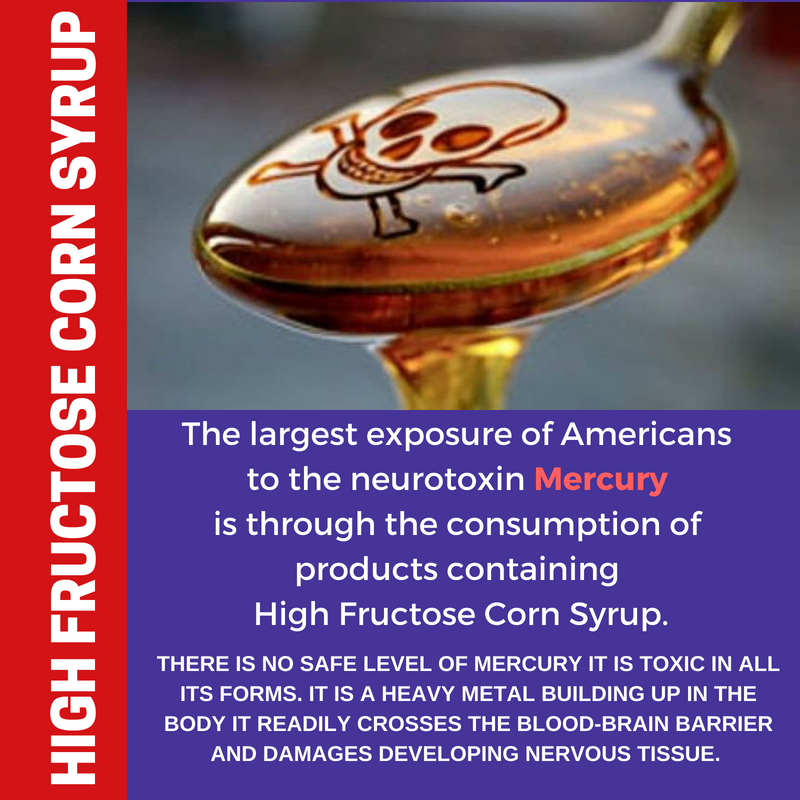MERCURY Contaminates High Fructose Corn Syrup

There were already plenty of reasons to avoid the highly processed high fructose corn syrup like the plague. Now there’s an even better reason. High fructose corn syrup (HFCS) makes up one out of every ten calories Americans eat. It is in nearly every processed food and sweetened beverage. Americans consume about 150 pounds of sugars per person per year, forty one pounds of which is in the form of HFCS, making HFCS one of the principal drivers behind heart attacks, strokes, cancer, dementia, and diabetes. Now we learn that high fructose corn syrup (also called fructose) contains the neurotoxic heavy metal mercury that has been known to cause mood disorders, behavioral disorders, dementias of various kinds, memory loss, or many, many other serious health conditions.
A 2009 study led by a former FDA employee found that half of tested samples of HFCS contained mercury. Another study found nearly a third of tested commercial products containing HFCS were contaminated with mercury. In a statement released with the study, one of the authors remarked:
Mercury is toxic in all its forms. Given how much high-fructose corn syrup is consumed by children, it could be a significant additional source of mercury never before considered. Potentially, the largest exposure of Americans to the neurotoxin mercury is through the consumption of products containing High Fructose Corn Syrup.

The circumstances leading up to the study are even more alarming.
Years before the study, the lead author, Renee Dufault, was an environmental health researcher at the FDA conducting research on chlor-alkali processing plants. These plants use mercury to produce chlorine and caustic soda—sodium hydroxide, a chemical base used in manufacturing paper, textiles, and many other products, including HFCS. In 2003, the Environmental Protection Agency (EPA) reported that about seven tons of mercury were missing from the eight chlor-alkali processing plants in the US. Every year, in fact, these plants reported missing mercury to the EPA. Due to the public health nightmare this poses—since exposure to mercury in even small amounts can cause serious health problems—Dufault began investigating where the missing mercury was going.
Dufault learned that mercury residue in chlor-alkali plants could be found in all products made with mercury, and that caustic soda from these plants was used heavily by the HFCS industry.
She conducted tests and found that 45% of HFCS samples tested positive for mercury contamination. In 2005 she presented her findings to the FDA, but was instructed to drop the issue altogether.
THE FDA (CHARGED WITH REGULATING SAFETY) INSTRUCTED THE RESEARCHER WHO DISCOVERED THE NERUOTOXIC CONTAMINATION TO IGNORE SERIOUS HEALTH SAFETY ISSUE.
Dufault said that the FDA began taking her off field projects and wanted her “to sit in an office.” When Dufault left the FDA in 2008, she decided to go public with her findings.
Following up on Dufault’s report, the Institute for Agriculture and Trade Policy found that nearly one-third of the fifty-five brand-name products they tested were contaminated with mercury. For a list of those products, you can consult the full report here.
The FDA and the HFCS industry say there is nothing to worry about. The agency said the mercury in Dufault’s samples was elemental mercury and thus safer than other forms of mercury—although no scientific evidence was provided to substantiate such a claim. Know this, there is no safe level of mercury exposure! None! The lab that originally analyzed the samples even said it was likely that the kind found in the HFCS samples was organic mercury—which is the form most dangerous to human health.
The peril mercury poses to human health, especially to young children with developing brains, cannot be understated.
As Dufault and her colleagues point out in the article, mercury in any form is toxic. Organic mercury readily crosses the blood-brain barrier and damages developing nervous tissue. Even if only trace amounts are found in HFCS-containing products, the amount of HFCS that Americans consume every day without even realizing it makes this a huge concern—especially given the propensity of metals like mercury to accumulate over time. Americans consume Over 41 Pounds of Mercury-Laden HFCS each year.
Dr. Harmon of Clear Mind Center Idaho says, “We see signs of heavy metal toxicity on the brain maps we do at the office. These are neurotoxins and affect the brain. Symptoms are commonly fuzzy brain, ADD/ADHD, learning disorders, and many more.”
Renamed HFCS Is Grossly Misleading
In 2010, the Corn Refiners Association tried to improve the image of HFCS by petitioning that it be renamed “corn sugar.” Thankfully, the Food and Drug Administration turned down their request in 2012. Now, manufacturers have changed the name of a form of HFCS called HFCS-90 to fructose. Regular HFCS contains 42 to 55 percent fructose, while HFCS-90 contains 90 percent.
In other words, the food ingredient now called fructose contains even higher concentrations of one of the primary components within HFCS linked to health issues. Rather than being a healthier product, which the name implies, it is more of health risk than regular HFCS. In fact, since it contains more fructose, the FDA declined to recognize HFCS-90 as safe.
Food companies are taking advantage of the name change to hide HFCS in their products. On the front of General Mills’ Vanilla Chex cereal box, it says the product contains “no high fructose corn syrup.” Yet in the ingredients, it lists fructose, the more concentrated form of HFCS. This means manufacturers are successfully concealing the fact that their products contain the ingredient consumers want to avoid.
8 Deceiving Names for High Fructose Corn Syrup
1. Maize syrup
2. Glucose syrup
3. Glucose/fructose syrup
4. Tapioca syrup
5. Fruit fructose
6. Crystalline fructose
7. HFCS
8. Fructose
Are you concerned?
Mercury contamination was discovered in 2009. The FDA ignored it. In 2010, the FDA then granted permission to manufacturers permission to use a new name. Now almost a decade later, have the producers of high fructose corn syrup/fructose changed the way of processing to avoid mercury contamination? An extensive search on FDA website doesn’t indicate any change in processing requirements to eliminate mercury contamination were ever made.
RESOURCES:
This article originally appeared at: http://www.anh-usa.org/mercury-found-in-high-fructose-corn-syrup/.
Report: http://www.academicjournals.org/journal/BMBR/article-full-text-pdf/41CAC0411547
Effective of Mercury on the human body: http://www.greenfacts.org/en/mercury/l-2/mercury-2.htm





